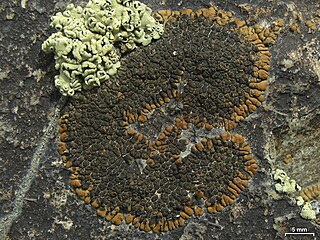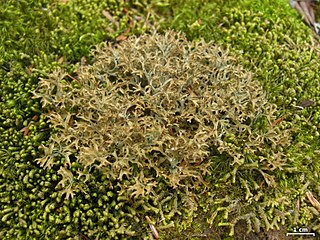
Cetraria islandica, also known as true Iceland lichen or Iceland moss, is an Arctic-alpine lichen whose erect or upright, leaflike habit gives it the appearance of a moss, where its name likely comes from.

Cetraria is a genus of fruticose lichens that associate with green algae as photobionts. Most species are found at high latitudes, occurring on sand or heath. Species have a characteristic "strap-like" form, with spiny lobe edges.
Geltingia is a fungal genus in the family Helicogoniaceae. It is monotypic, containing the single lichenicolous species Geltingia associata. The genus was circumscribed in 1990 by mycologists Vagn Alstrup and David Leslie Hawksworth. The genus name honours Danish scientist Paul Gelting.

Sphaerellothecium is a genus of fungi in the family Phyllachoraceae. All of the species in the genus are lichenicolous, meaning they grow parasitically on lichens.

Cetraria aculeata or the spiny Iceland lichen is a dark brown to black fruticose, soil Iceland lichen from the family Parmeliaceae. The species was first described by German naturalist Johann Christian Daniel Edler von Schreber in 1771 under the name of Lichen aculeatus. Later on, Erik Acharius, the "father of lichenology" gave it a name of Cornicularia aculeata, which lately has been changed to Coelocaulon aculeatum. Finally, the taxonomic revision of Ingvar Kärnefelt and colleagues assigned the species to the genus Cetraria.

Lecanora cenisia is a species of crustose lichen in the family Lecanoraceae. It is a known host of the lichenicolous fungus species Carbonea supersparsa.

Stereocaulon alpinum is a species of fungus belonging to the family Stereocaulaceae. It is similar to Stereocaulon paschale but differs from it in containing cyanobacteria of the genus Nostoc while S. paschale contains cyanobacteria of the genus Stigonema, which have a darker colour than Nostoc.
Lichenopeltella rangiferinae is a species of fungus belonging to the class Dothideomycetes. It was discovered growing on Cladonia rangiferina in Hrútey near Blönduós, Iceland and subsequently described as new to science in 2011.
Lichenopeltella santessonii is a species of lichenicolous fungus belonging to the class Dothideomycetes. It was first formally described as a new species of Micropeltopsis in 1990 by mycologists Paul Kirk and Brian Spooner. The specific epithet honours Swedish lichenologist Rolf Santesson, who collected the type specimen in Sala Municipality, Sweden, where it was growing on the foliose lichen Peltigera canina. Santesson transferred the taxon to the genus Lichenopeltella in 1993.
Carbonea supersparsa is a species of lichenicolous fungus belonging to the family Lecanoraceae. It is widespread in the Northern Hemisphere. In Iceland it has been reported growing on Lecanora cenisia near Egilsstaðir and Lecanora polytropa near Seyðisfjörður.

Carbonea vitellaria is a species of lichenicolous fungus belonging to the family Lecanoraceae. It has a worldwide distribution. In Iceland it has been reported growing on Candelariella vitellina near Egilsstaðir and on King George Island, Antarctica.

Muellerella lichenicola is a species of lichenicolous fungus in the family Verrucariaceae. It was first formally described as a new species in 1826 by Søren Christian Sommerfelt, as Sphaeria lichenicola. David Leslie Hawksworth transferred it to the genus Muellerella in 1979.

Muellerella ventosicola is a species of lichenicolous fungus in the family Verrucariaceae. It shows preference to growing on species of the genus Rhizocarpon but can also associate with other genera.
Lichenopeltella cetrariae is a species of fungus belonging to the class Dothideomycetes. It has been found growing on Cetraria aculeata in Hrútey near Blönduós, Iceland and on Cetraria laevigata in Bulgan district, Mongolia and Toyama prefecture, Japan. In Japan, it has also been reported growing on Flavocetraria cucullata in Yamanashi prefecture and Nagano prefecture.
Lichenopeltella uncialicola is a species of fungus belonging to the class Dothideomycetes. The species was discovered in Iceland in 2010 where it was found growing on Cladonia uncialis. Since then, it has been found on a different host species, Cladonia rangiferina, in North-Korea, Italy Austria, and Greenland.

Muellerella pygmaea is a species of lichenicolous fungus in the family Verrucariaceae. It has a cosmopolitan distribution in Arctic-alpine areas and grows on the thallus and apothecia of a number of hosts.
Neoechinodiscus kozhevnikovii is a species of lichenicolous (lichen-eating) fungus in the order Helotiales. It is known to occur in Russia, Austria, and Switzerland, where it grows parasitically on lichens in genus Cetraria.
Endococcus hafellneri is a species of lichenicolous (lichen-eating) fungus in the family Verrucariaceae. It is found in North Asia and the Russian Far East, Estonia, and Japan, where it grows on the lobes of the lichens Flavocetraria cucullata and Cetraria islandica.

Cetraria laevigata is a species of ground-dwelling, fruticose (bushy) lichen in the family Parmeliaceae. It was formally described as a new species by Russian lichenologist Kseniya Aleksandrovna Rassadina in 1943. In North America, it is commonly known as the striped Iceland lichen.









